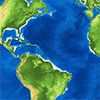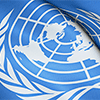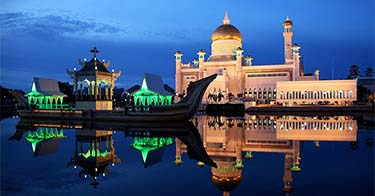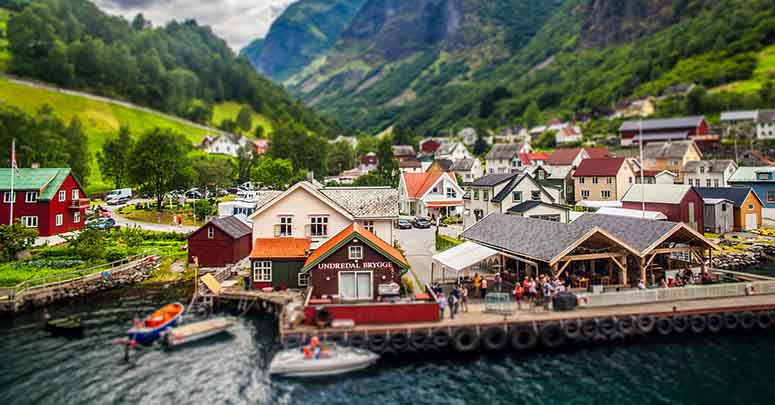People
Largest Countries In The World - Top 15
Updated February 4, 2020
Which country on earth is largest by area? Here are the biggest countries according to the latest statistics from the United Nations.
A country in this list means a sovereign state, which has a firmer definition than a country. A sovereign state is a geographical area with an independent political government. For example, the United Kingdom is a sovereign state, but Scotland is not, since Scotland is partly governed by the UK Parliament. In the same way, China is a sovereign state but Tibet is not, since Tibet is unwillingly ruled by China. Nor is Greenland a sovereign state, even though it has become increasingly independent from Denmark.
So how big is Denmark then? You'll find the answer in this list of the largest countries in the world, where all areas are taken from the UN's latest proper statistics, compiled in 2018. The area numbers in this list refer to the country's total surface area, comprising land area and inland waters (major rivers and lakes) and excluding polar regions and uninhabited islands. The population numbers are also taken from the UN:s latest reliable statistics.
A country in this list means a sovereign state, which has a firmer definition than a country. A sovereign state is a geographical area with an independent political government. For example, the United Kingdom is a sovereign state, but Scotland is not, since Scotland is partly governed by the UK Parliament. In the same way, China is a sovereign state but Tibet is not, since Tibet is unwillingly ruled by China. Nor is Greenland a sovereign state, even though it has become increasingly independent from Denmark.
So how big is Denmark then? You'll find the answer in this list of the largest countries in the world, where all areas are taken from the UN's latest proper statistics, compiled in 2018. The area numbers in this list refer to the country's total surface area, comprising land area and inland waters (major rivers and lakes) and excluding polar regions and uninhabited islands. The population numbers are also taken from the UN:s latest reliable statistics.
Advertisement:
15. Indonesia
Area: 1 910 931 km2 (737,815 mi2)
[1]
The fact that Indonesia is one of the largest countries in the world can be difficult to see on a map since the country consists solely of islands. This means there are many different ethnic groups within the country. Most people live on Java, the elongated island northwest of Australia. This is where the country's capital Jakarta is located.
Indonesia has a total of 264 million inhabitants (2018)[2], which makes it the fourth most populous country in the world.
The fact that Indonesia is one of the largest countries in the world can be difficult to see on a map since the country consists solely of islands. This means there are many different ethnic groups within the country. Most people live on Java, the elongated island northwest of Australia. This is where the country's capital Jakarta is located.
Indonesia has a total of 264 million inhabitants (2018)[2], which makes it the fourth most populous country in the world.
14. Mexico
Area: 1 964 375 km2 (758,449 mi2)
[1]
Of Mexico's 125 million inhabitants (2018)[2], some are always on their way into the United States. For Mexico shares a more than three thousand kilometer long border with "the land of opportunity".
Mexico is traversed by four mountain ranges, which is the reason many cities are located at pretty high altitudes. The long and narrow peninsula is called La península de Baja California (The Baja California Peninsula in english), and it is separated from the rest of Mexico by the Colorado River.
Of Mexico's 125 million inhabitants (2018)[2], some are always on their way into the United States. For Mexico shares a more than three thousand kilometer long border with "the land of opportunity".
Mexico is traversed by four mountain ranges, which is the reason many cities are located at pretty high altitudes. The long and narrow peninsula is called La península de Baja California (The Baja California Peninsula in english), and it is separated from the rest of Mexico by the Colorado River.
Advertisement:
13. Saudi Arabia
Area: 2 206 714 km2 (830,000 mi2)
[1]
Saudi Arabia is the largest country in the Middle East and constitutes most of the Arabian Peninsula. Almost all of the country has a desert climate, except the Red Sea coast (to the southwest). This is where most of the population live in cities.
Saudi Arabia has 33 million inhabitants (2018).[2]
Saudi Arabia is the largest country in the Middle East and constitutes most of the Arabian Peninsula. Almost all of the country has a desert climate, except the Red Sea coast (to the southwest). This is where most of the population live in cities.
Saudi Arabia has 33 million inhabitants (2018).[2]
12. Denmark (including Greenland and Faroe Islands)
Area: 2 210 415 km2 (853,446 mi2)
[1]
Greenland was a Danish colony in 1721-1953 and after that a Danish amt (sort of a county) in 1953-1979. The population of Greenland then got political self-government through a referendum in 1979 and is now considered an "autonomous country within in the Danish Realm". The same happened in 1948 with the Faroe Islands, a small group of islands between Norway, Great Britain and Iceland. The control of foreign affairs, defence and finances is however still retained by Denmark.
Greenland's area is 2,166,086 km2.[1] If Greenland and the Faroe Islands are considered part of Denmark, then Denmark's area is 2 210 415 km2.[1] Either way, Greenland/Denmark is number 12 on this list of the largest countries in the world.
Greenland has a population of only 56,000 (2018)[2], of which the great majority are inuits. Almost all people live along the fjords in southwestern Greenland, where the climate is relatively mild. Greenland is today much like Scandinavia 10,000 years ago, in the way that almost the entire land is covered by a thick ice sheet.
Greenland was a Danish colony in 1721-1953 and after that a Danish amt (sort of a county) in 1953-1979. The population of Greenland then got political self-government through a referendum in 1979 and is now considered an "autonomous country within in the Danish Realm". The same happened in 1948 with the Faroe Islands, a small group of islands between Norway, Great Britain and Iceland. The control of foreign affairs, defence and finances is however still retained by Denmark.
Greenland's area is 2,166,086 km2.[1] If Greenland and the Faroe Islands are considered part of Denmark, then Denmark's area is 2 210 415 km2.[1] Either way, Greenland/Denmark is number 12 on this list of the largest countries in the world.
Greenland has a population of only 56,000 (2018)[2], of which the great majority are inuits. Almost all people live along the fjords in southwestern Greenland, where the climate is relatively mild. Greenland is today much like Scandinavia 10,000 years ago, in the way that almost the entire land is covered by a thick ice sheet.
11. Democratic Republic Of The Congo
Area: 2 344 858 km2 (905,355 mi2)
[1]
The Democratic Republic of the Congo, formerly known as Zaire, also known as Congo-Kinshasa, is the second largest country in Africa. It should not be confused with the Republic of the Congo, also known as Congo-Brazzaville, which is a much smaller country situated just west of The Democratic Republic of the Congo.
The Democratic Republic of the Congo was hit hard by war in 1998-2003, and violence still rages in many areas. On a brighter note, there are beautiful rainforests in the country where you can find chimpanzees and gorillas.
The Democratic Republic of the Congo, formerly known as Zaire, also known as Congo-Kinshasa, is the second largest country in Africa. It should not be confused with the Republic of the Congo, also known as Congo-Brazzaville, which is a much smaller country situated just west of The Democratic Republic of the Congo.
The Democratic Republic of the Congo was hit hard by war in 1998-2003, and violence still rages in many areas. On a brighter note, there are beautiful rainforests in the country where you can find chimpanzees and gorillas.
10. Algeria
Area: 2 381 741 km2 (919,595 mi2)
[1]
Algeria is the tenth biggest country in the world, and the largest country in Africa. It is also one of the most arid countries on earth - a large part of Algeria is covered by the Sahara, so most of the 41 million inhabitants (2017)[2] live along the north coast. The country is quite hilly and mountainous, with two mountain ranges traversing the country.
Algeria is the tenth biggest country in the world, and the largest country in Africa. It is also one of the most arid countries on earth - a large part of Algeria is covered by the Sahara, so most of the 41 million inhabitants (2017)[2] live along the north coast. The country is quite hilly and mountainous, with two mountain ranges traversing the country.
9. Kazakhstan
Area: 2 724 902 km2 (1,052,100 mi2)
[1]
Kazakhstan is not only the home of Borat, but also the world's ninth largest country by area, and the largest country in the world surrounded only by land borders (except for the Caspian Sea). Kazakhstan was part of the Soviet Union, and became independent in 1991.
Kazakhstan has many types of nature; soaring mountains, canyons, grasslands, steppe and more. The climate is a bit cold and dry in general, and the country has distinct seasons.
Kazakhstan has a population of only 18 million (2018)[2], which is not that much for such a large country.
Kazakhstan is not only the home of Borat, but also the world's ninth largest country by area, and the largest country in the world surrounded only by land borders (except for the Caspian Sea). Kazakhstan was part of the Soviet Union, and became independent in 1991.
Kazakhstan has many types of nature; soaring mountains, canyons, grasslands, steppe and more. The climate is a bit cold and dry in general, and the country has distinct seasons.
Kazakhstan has a population of only 18 million (2018)[2], which is not that much for such a large country.
8. Argentina
Area: 2 796 427 km2 (1,079,707 mi2)
[1]
The second largest country in South America is Argentina. Like most countries of this size, it has many different types of nature, and you can find everything from snow-covered mountains to warm seashores. Since the country stretches far from the north to the south the climate varies from suptropical to subarctic. Central Argentina has a temperate climate, like most of Europe.
Argentina has a population of 44 million (2018).[2]
The map also shows the area in Antarctica that Argentina claimed until 1959, when the Antarctic Treaty was signed and all countries had to waive their claims.
The second largest country in South America is Argentina. Like most countries of this size, it has many different types of nature, and you can find everything from snow-covered mountains to warm seashores. Since the country stretches far from the north to the south the climate varies from suptropical to subarctic. Central Argentina has a temperate climate, like most of Europe.
Argentina has a population of 44 million (2018).[2]
The map also shows the area in Antarctica that Argentina claimed until 1959, when the Antarctic Treaty was signed and all countries had to waive their claims.
7. India
Area: 3 287 263 km2 (1,269,219 mi2)
[1]
India is the seventh largest and the second most populous country in the world. A total of 1.30 billions of people live in India (2018).[2]
The Indian subcontinent slowly moves to the north and pushes against the rest of Asia, which is why the Himalaya rises like a roof in the northern parts of the country. Besides mountains, India has deserts, great plains, rainforests, beaches and many other types of landscape. The climate is either dry or wet, and always warm, except in the mountainous parts where it obviously is colder.
India is the seventh largest and the second most populous country in the world. A total of 1.30 billions of people live in India (2018).[2]
The Indian subcontinent slowly moves to the north and pushes against the rest of Asia, which is why the Himalaya rises like a roof in the northern parts of the country. Besides mountains, India has deserts, great plains, rainforests, beaches and many other types of landscape. The climate is either dry or wet, and always warm, except in the mountainous parts where it obviously is colder.
6. Australia
Area: 7 692 024 km2 (2,969,907 mi2)
[1]
Australia was in the 18th and 19th centuries literally invaded by Europeans, and their descendants constitute the largest part of the 25 million inhabitants (2018)[2] today. The indigenous people of Australia, the Aboriginals, only constitute a fraction. The remaining population is mostly of Asians descent.
The southwestern parts of the nation has a temperate climate, while the rest of the continent is hotter. In the middle of Australia are several large deserts, and the population density is very low here. The deserts are surrounded by grasslands, which in turn are surrounded by forests. But in northwestern Australia, the desert stretches all the way to the coast. The northeastern part of the country has rainforests.
Australia was in the 18th and 19th centuries literally invaded by Europeans, and their descendants constitute the largest part of the 25 million inhabitants (2018)[2] today. The indigenous people of Australia, the Aboriginals, only constitute a fraction. The remaining population is mostly of Asians descent.
The southwestern parts of the nation has a temperate climate, while the rest of the continent is hotter. In the middle of Australia are several large deserts, and the population density is very low here. The deserts are surrounded by grasslands, which in turn are surrounded by forests. But in northwestern Australia, the desert stretches all the way to the coast. The northeastern part of the country has rainforests.
5. Brazil
Area: 8 515 767 km2 (3,287,956 mi2)
[1]
The largest country in South America, and the fifth largest country in the world, is Brazil. With its 208 million inhabitants (2018)[2] it is also the world's fifth most populous country.
Rainforests are typical for Brazil, as the entire northwestern part of Brazil is covered by the Amazon Jungle. The rest of the country is mainly covered by other forests and shrubbery. The climate is tropical throughout the country, except along the south where it is temperate.
The largest country in South America, and the fifth largest country in the world, is Brazil. With its 208 million inhabitants (2018)[2] it is also the world's fifth most populous country.
Rainforests are typical for Brazil, as the entire northwestern part of Brazil is covered by the Amazon Jungle. The rest of the country is mainly covered by other forests and shrubbery. The climate is tropical throughout the country, except along the south where it is temperate.
4. China
Area: 9 600 000 km2 (3,700,000 mi2)
[1]
The largest of all countries in Asia, and fourth largest in the world, is China. China has the biggest population in the world - 1.40 billion (including Hong Kong and Macau) (2018).[2]
In 1979, China introduced a policy limiting couples to a single child. This policy was strict in some areas and looser in others. A survey in 2007 showed its extent: 36 % were allowed only one child (mostly people in the cities), 53 % were allowed two children if the first child was a girl (people in cities and rural areas), 10 % were allowed two children regardless of the gender of the first child (mainly people in rural areas) and 2 % were allowed as many children as they wanted (mainly Tibetans).[3] The one-child policy was enforced through income-based fines. The policy led to newborn girls being abandoned, given away for adoption or murdered, since China's culture in different ways favors families with sons. In 2015, the one-child policy began to be phased out, mainly because there were now too many men, too few young and too many old.
The landscape in China is very varied and hard to describe briefly. Generally, southeastern China is covered by forests, while northwestern China has grasslands, steppes and deserts.
The light green areas on the map are China's claimed but uncontrolled territories; Taiwan and disputed land bordering India.
The largest of all countries in Asia, and fourth largest in the world, is China. China has the biggest population in the world - 1.40 billion (including Hong Kong and Macau) (2018).[2]
In 1979, China introduced a policy limiting couples to a single child. This policy was strict in some areas and looser in others. A survey in 2007 showed its extent: 36 % were allowed only one child (mostly people in the cities), 53 % were allowed two children if the first child was a girl (people in cities and rural areas), 10 % were allowed two children regardless of the gender of the first child (mainly people in rural areas) and 2 % were allowed as many children as they wanted (mainly Tibetans).[3] The one-child policy was enforced through income-based fines. The policy led to newborn girls being abandoned, given away for adoption or murdered, since China's culture in different ways favors families with sons. In 2015, the one-child policy began to be phased out, mainly because there were now too many men, too few young and too many old.
The landscape in China is very varied and hard to describe briefly. Generally, southeastern China is covered by forests, while northwestern China has grasslands, steppes and deserts.
The light green areas on the map are China's claimed but uncontrolled territories; Taiwan and disputed land bordering India.
3. United States
Area: 9 833 517 km2 (3,796,742 mi2)
[1]
The Unites States of America make up the middle part of the North American continent. With the exception of the two states of Alaska and Hawaii, which are far away from the rest of the country, USA borders only Canada in the north and Mexico in the south.
The west coast has a mediterranean climate in the south, and a cooler oceanic climate in the north. Inland from the west coast are arid deserts, steppes and mountain chains. The eastern half of the United States is relatively flat. Here, the southern part has a subtropical climate while the northern part has a temperate climate.
USA has a population of 323 million people (2017)[2], which makes the country the third most populous in the world after China and India.
The Unites States of America make up the middle part of the North American continent. With the exception of the two states of Alaska and Hawaii, which are far away from the rest of the country, USA borders only Canada in the north and Mexico in the south.
The west coast has a mediterranean climate in the south, and a cooler oceanic climate in the north. Inland from the west coast are arid deserts, steppes and mountain chains. The eastern half of the United States is relatively flat. Here, the southern part has a subtropical climate while the northern part has a temperate climate.
USA has a population of 323 million people (2017)[2], which makes the country the third most populous in the world after China and India.
2. Canada
Area: 9 984 670 km2 (3,855,100 mi2)
[1]
Number two on the list of the largest sovereign states in the world is Canada. Canada has Elizabeth II of the United Kingdom as its monarch, but is still defined as a sovereign state. The queen has power in certain rare situations, but she would hardly act against the parliament of Canada if such situations would occur.
Canada extends all the way to the Arctic Ocean and Greenland in the north. Winters are harsh in large parts of the country, especially inland. The land is dominated by tundra in the north, mountains in the west and forests in the southeast. Inland in the south are prairies, where summers can be really hot. The climate along the coasts is moderated by the oceans.
The magnetic North Pole is in northern Canada.
Canada has 37 million inhabitants (2018)[2], most of which live near the US border.
Number two on the list of the largest sovereign states in the world is Canada. Canada has Elizabeth II of the United Kingdom as its monarch, but is still defined as a sovereign state. The queen has power in certain rare situations, but she would hardly act against the parliament of Canada if such situations would occur.
Canada extends all the way to the Arctic Ocean and Greenland in the north. Winters are harsh in large parts of the country, especially inland. The land is dominated by tundra in the north, mountains in the west and forests in the southeast. Inland in the south are prairies, where summers can be really hot. The climate along the coasts is moderated by the oceans.
The magnetic North Pole is in northern Canada.
Canada has 37 million inhabitants (2018)[2], most of which live near the US border.
1. Russia
Area: 17 098 246 km2 (6,601,670 mi2)
[1]
The largest country in the world, by far, is Russia. The country spans across all of northern Asia and parts of Europe. Russia has a population of 144 million people (2013)[2], which makes it the ninth most populous country in the world.
Most of this big country consists of large, flat areas. In the south are steppes, in the middle coniferous forests, and in the north tundra. There are also a fair amount of mountains, lakes and rivers. The largest part of the country has a temperate climate, but the northern parts has a subarctic climate with very cold winters. The north coast, which is often snow-covered all year round, has an arctic climate.
The largest country in the world, by far, is Russia. The country spans across all of northern Asia and parts of Europe. Russia has a population of 144 million people (2013)[2], which makes it the ninth most populous country in the world.
Most of this big country consists of large, flat areas. In the south are steppes, in the middle coniferous forests, and in the north tundra. There are also a fair amount of mountains, lakes and rivers. The largest part of the country has a temperate climate, but the northern parts has a subarctic climate with very cold winters. The north coast, which is often snow-covered all year round, has an arctic climate.
References
[1]
"Population by sex, annual rate of population increase, surface area and density / United Nations Demographic Yearbook 2018". UN. Published 2019. Retrieved Feb 4, 2020.
[2]
"Population by sex and urban/rural residence". UN. Published 2015. Retrieved Feb 4, 2020.
[3]
"China relaxes its one-child policy". The Australian. Published Jan 24, 2007. Retrieved Feb 4, 2020.
Related
Latest



















































